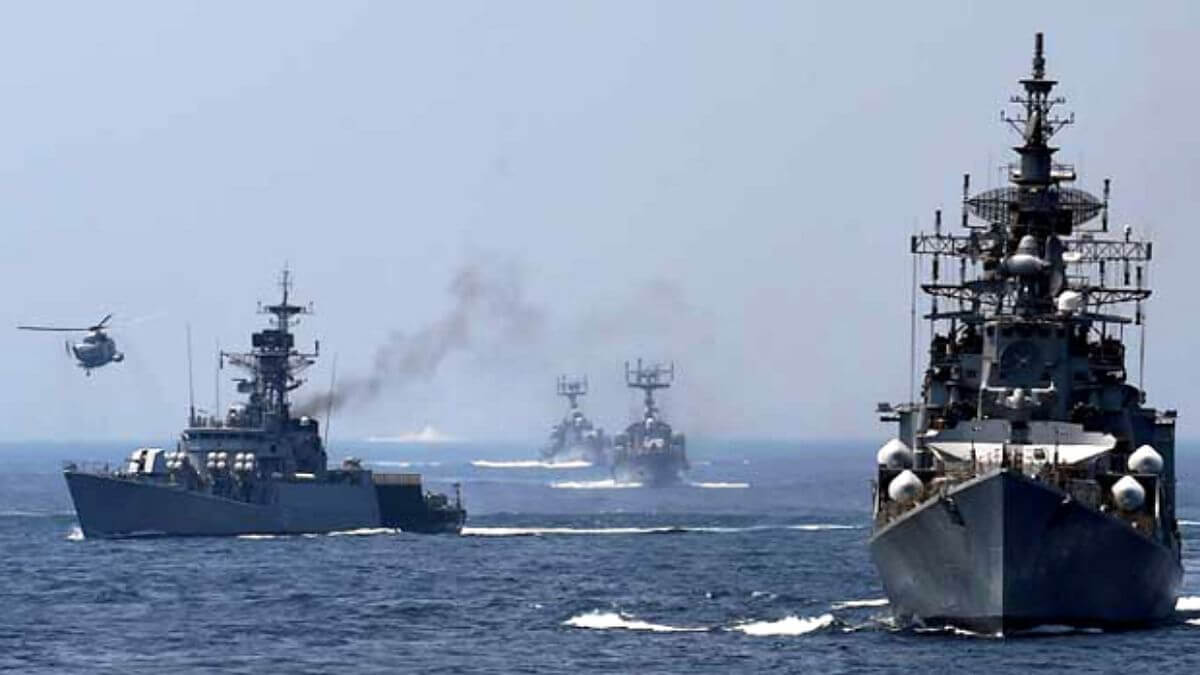The first phase of the Malabar naval exercise between Australia, India, the United States (US), and Japan begins today off the coast of Vishakhapatnam in the Bay of Bengal. The first phase of the drill is scheduled to run from November 3-6, and the second phase is scheduled for later this month, from November 17-20 in the Arabian Sea.
This is the first time in 13 years that the four countries have come together in the Malabar naval exercise; the last time that Australia was part of the exercise in 2007. Australian Defense Minister Linda Reynolds said in a statement that “high-end military exercises like Malabar are key to enhancing Australia’s maritime capabilities, building interoperability with our close partners, and demonstrating our collective resolve to support an open and prosperous Indo-Pacific.”
What also makes the addition of Australia important to the group exercises is that these four countries engage in several political and military dialogues outside of the Malabar exercises. In fact, over the past few months, the Indian navy has held passage exercises (PASSEX) with all three partner countries. Furthermore, Australia has elevated its relationship with India from a Strategic Partnership to a Comprehensive Strategic Partnership (CSP). In early June, PM Narendra Modi inked nine agreements with PM Scott Morrison, including a Shared Vision for Maritime Cooperation in the Indo-Pacific” and a Mutual Logistics Support Agreement (MLSA).
The ongoing exercise will be “conducted as a ‘non-contact, at sea only’ exercise in view of COVID-19 pandemic, will showcase the high-levels of synergy and coordination between the friendly navies, which is based on their shared values and commitment to an open, inclusive Indo-Pacific and a rules-based international order," an official of the Indian Navy said.
In terms of the assets fielded by participating defence forces, Phase-1 of Malabar will see the participation of U.S. guided-missile destroyer USS John S McCain, Australian long-range frigate HMAS Ballarat with the MH-60 helicopter, and Japanese destroyer JS Onami with the Sikorsky SH-60 Sea Hawk helicopter, the first official said.
The Indian side for Phase-I led by Rear Admiral Sanjay Vatsayan, Flag Officer Commanding Eastern Fleet, will see the participation of destroyer INS Ranvijay, stealth frigate INS Shivalik, off-shore patrol vessel INS Sukanya, fleet support ship INS Shakti and submarine INS Sindhuraj, an official said.
The joint military exercise comes in the midst of escalating tensions with China, for all nations involved in the drill. China, who has asserted its maritime dominance in the past, has always been suspicious of the Malabar exercise and views these exercises as a counter to its desired hegemony in the high seas. China is currently involved in territorial disputes with Japan, Vietnam, Malaysia, Brunei, Indonesia, and the Philippines. In addition, it has become increasingly close to Pakistan, and has engaged in aggressive posturing against India in the Indo-Pacific.
However, judging from the fleet, the first phase of the exercise is predicted to be mundane. Retired Indian Navy Commodore Venugopal Vengalil tweeted that a “more credible line up is required to send the right message to China if that is the intent.”
New Delhi said that all participants of the Malabar naval exercise “collectively support [a] free, open and inclusive Pacific and remain committed to a rules-based international order.”
Other nations have also made diplomatic moves to stand up to Chinese assertiveness. For instance, French President Emmanuel Macron announced his decision last month to appoint an envoy to the Indo-Pacific region. Christoph Penot, who will primarily focus on bolstering cooperation with India.
Last month, Germany, too, decided to strengthen its presence and partnerships in the Indo-Pacific with the aim of furthering the rule of law. Heiko Maas, Germany’s Foreign Minister said, “We want to help shape (the future global order) so that it is based on rules and international cooperation, not on the law of the strong. That is why we have intensified cooperation with those countries that share our democratic and liberal values.” India, Japan, and Australia came out in support of Germany’s decision. This was seen as a major blow to China, who was previously the central element for Germany’s diplomacy in Asia.
Malabar Naval Exercise Starts Today Amidst Tensions with China
The first phase of the expanded Malabar Naval Exercise begins today in the Bay of Bengal. Read more.
November 3, 2020

SOURCE: REPRESENTATIONAL IMAGE
